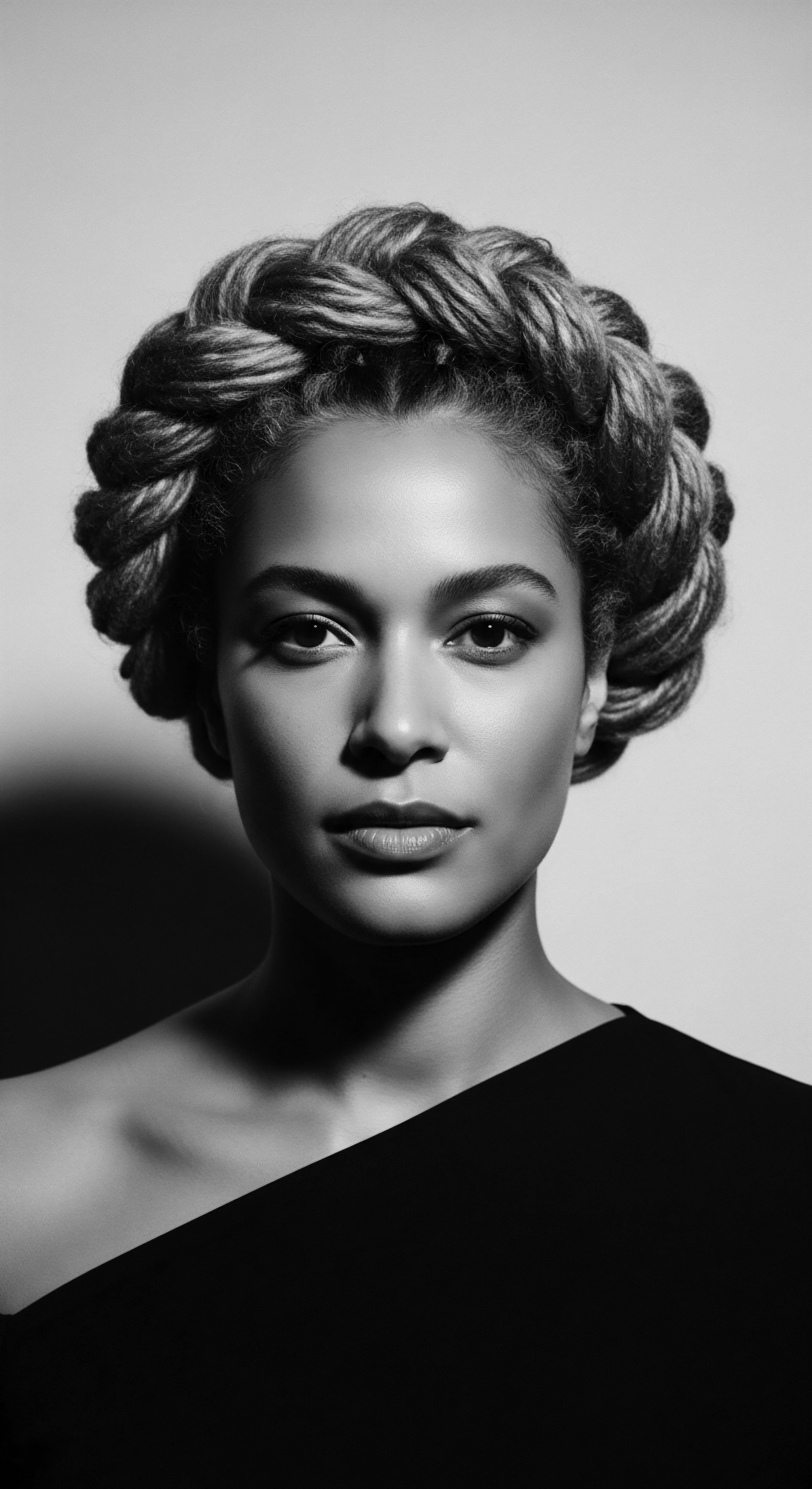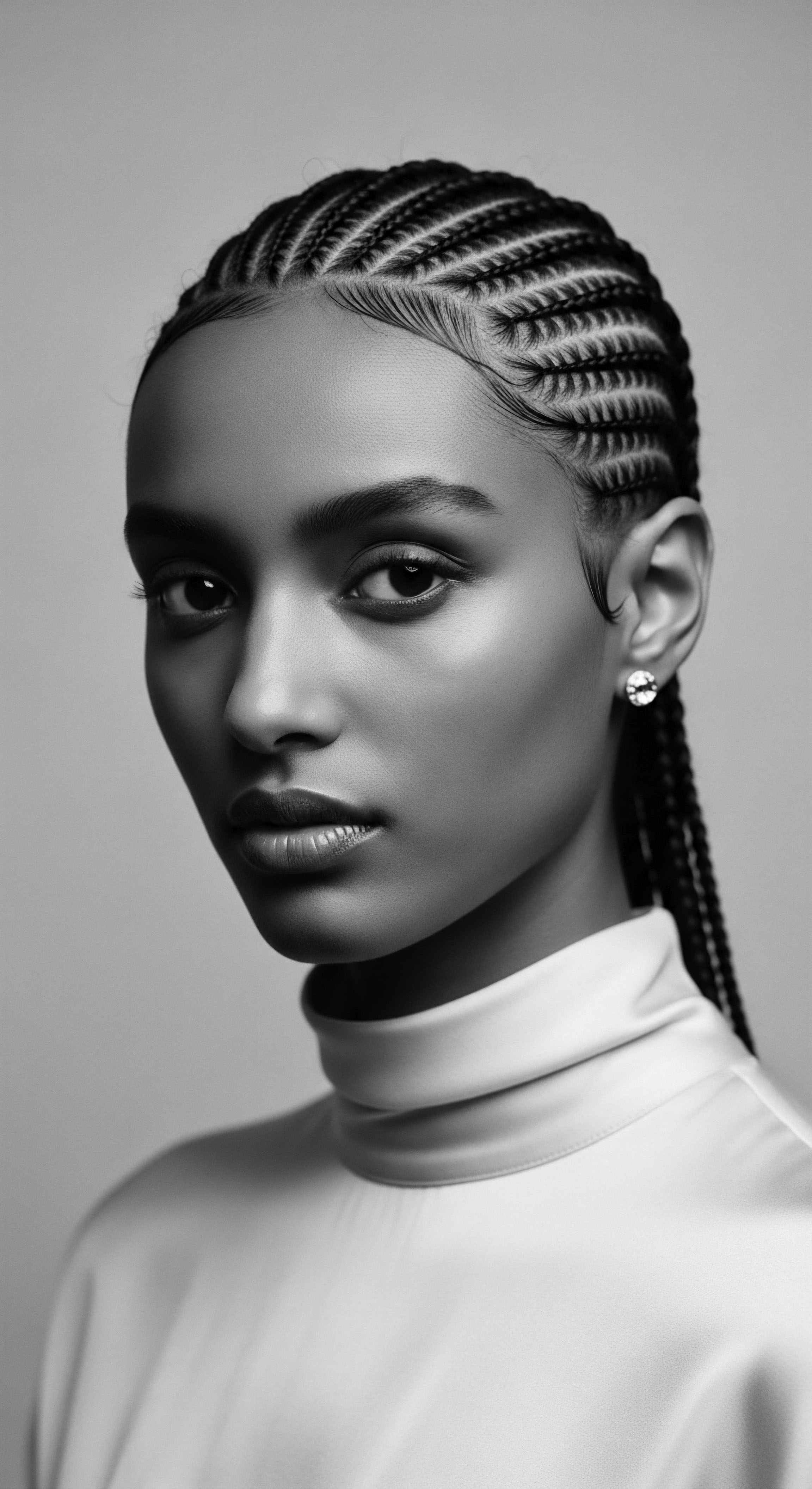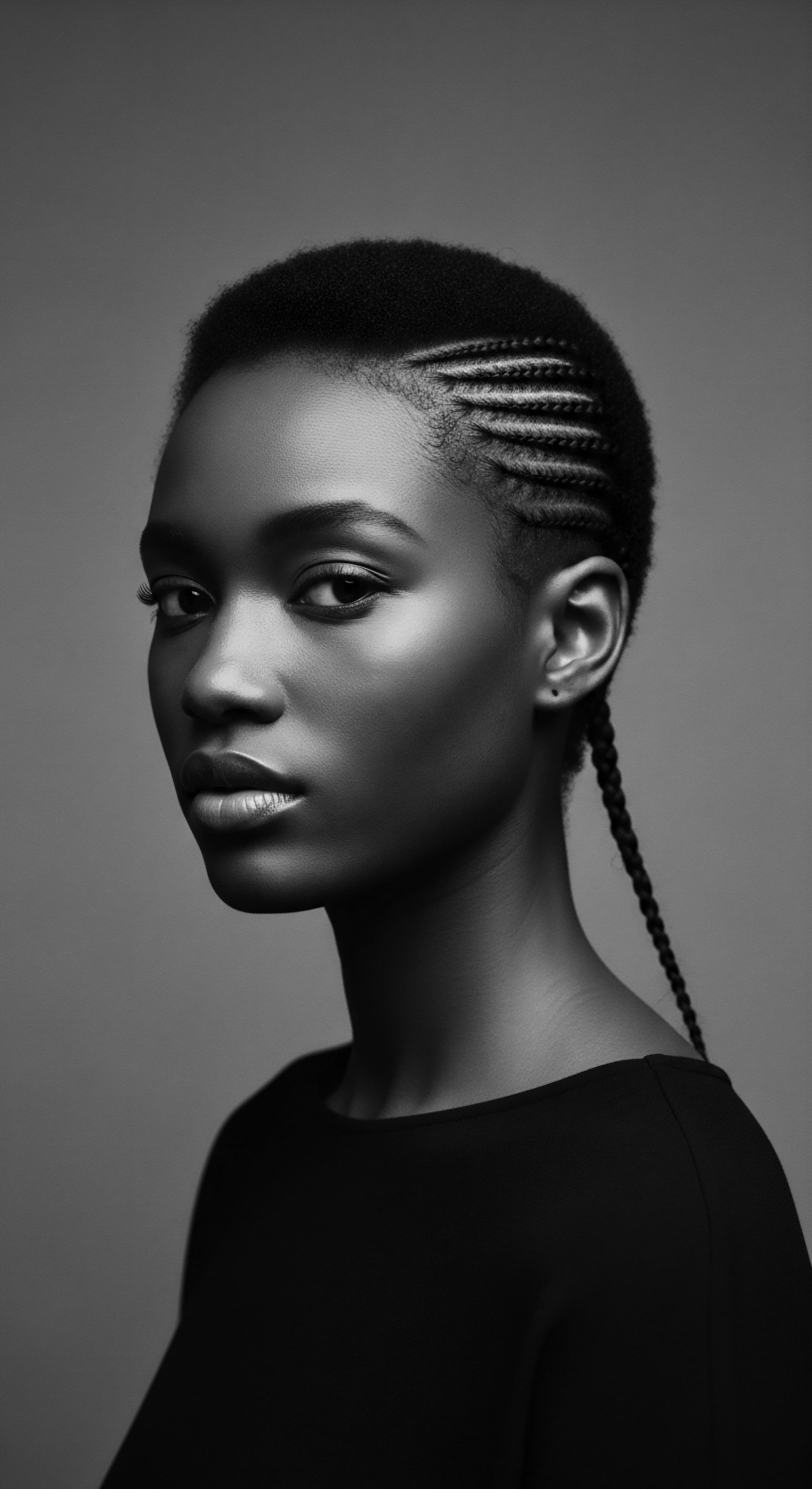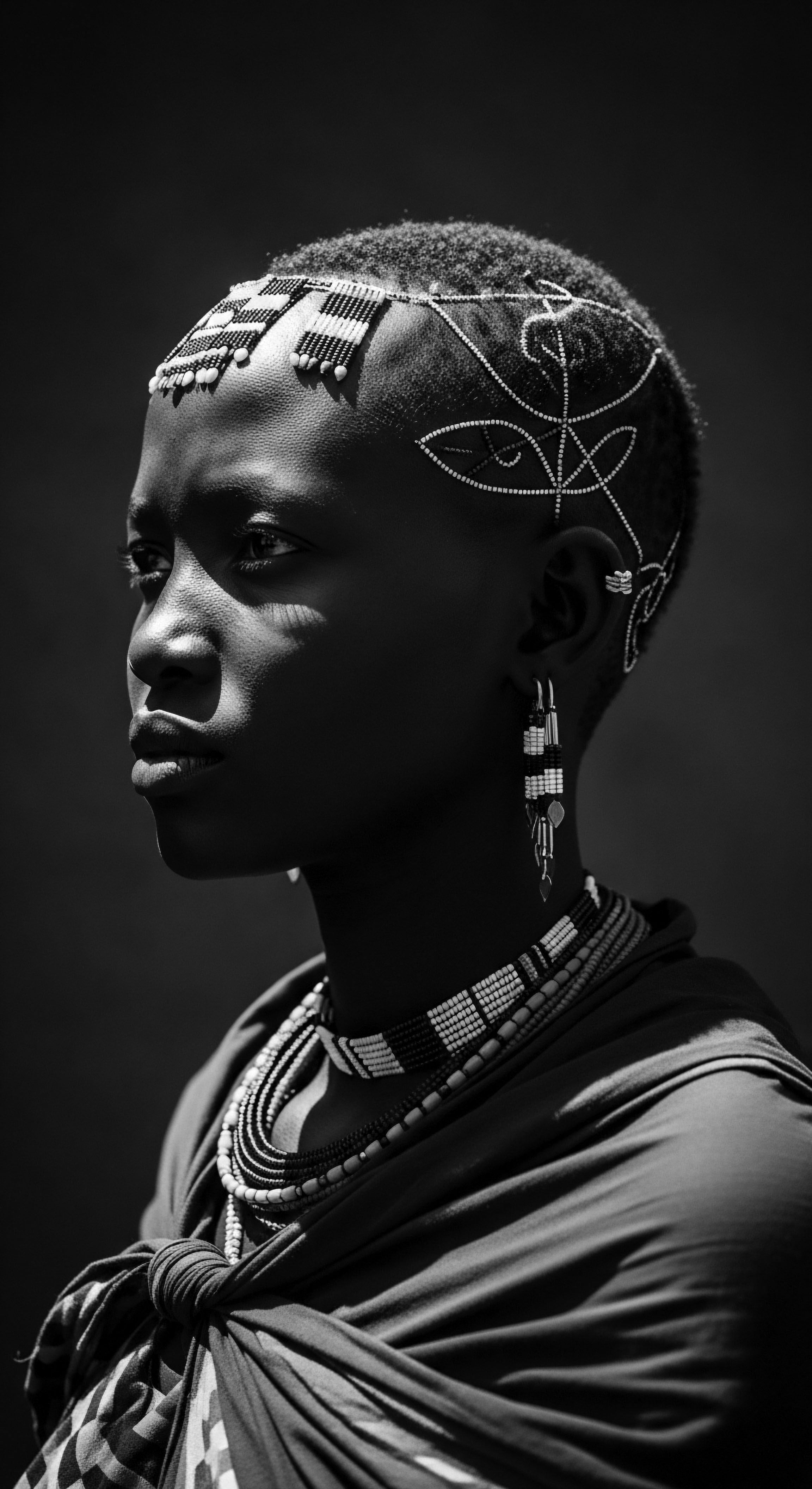
Roots
In the vast lineage of textured hair, a heritage flows that predates modern beauty aisles, reaching back to the sun-kissed lands of Africa. For generations, wisdom keepers across the continent recognized the vital force held within their indigenous plants, understanding these botanical allies were not simply adornments, but profound extensions of well-being and identity. The nourishment of curls, coils, and waves was then, as now, a deeply intentional practice, entwined with societal markers, spiritual connections, and the very rhythms of life.
To truly comprehend the needs of textured hair, particularly Black and mixed-race strands, we look to these ancestral blueprints, acknowledging that science often follows the paths carved by inherited knowledge. Each curl, each coil, holds a memory, a story of resilience and rooted care, speaking volumes of a history intimately linked with the earth’s bounty.

What is the Structure of Textured Hair?
The unique architecture of textured hair, a testament to evolutionary adaptation, distinguishes it in its curl pattern and inherent properties. From a biological standpoint, each strand emerges from a follicle that is typically elliptical or flat in shape, contrasting with the round follicles producing straight hair. This flattened follicle dictates the strand’s elliptical cross-section, causing it to coil upon itself as it grows. The degree of this coiling can range from loose waves to tight, spring-like coils, leading to varying densities of curves along the hair shaft.
This coiled structure, while visually stunning, also presents specific care considerations. The natural bends and turns along the hair shaft create points where the cuticle, the outermost protective layer, can lift. This characteristic leads to a propensity for moisture loss, making hydration a primary concern for preserving the hair’s integrity. Additionally, the hair’s spiraling nature means natural oils produced by the scalp struggle to travel down the entire length of the strand, contributing to dryness, especially at the ends.
Understanding these inherent qualities, passed down through genetic heritage, provides the foundation for effective nourishment practices. These biological realities were intuitively understood by ancestors, whose botanical remedies often addressed these exact challenges.
Textured hair’s distinct coiled structure, a legacy of evolutionary adaptation, requires specific nourishment to counter its natural inclination for moisture loss.

How does Ancestral Wisdom Classify Hair Types?
Before scientific classification systems sought to categorize hair based on curl patterns, ancestral wisdom approached hair classification through a lens of functionality, community, and often, spiritual significance. Rather than numerical types, hair was often described by its appearance, behavior, and the cultural practices it invited. A woman’s hair might be termed for its particular coil, its softness or strength, its ability to hold intricate styles, or even its perceived ancestral connections. Hair that was particularly resistant to breakage, or that responded well to certain plant extracts, would be valued for those qualities.
These observations were often qualitative, passed down through generations of communal grooming sessions where the nuances of different hair textures were intimately known and attended to. Knowledge was shared through the hands that braided, twisted, and massaged, discerning the needs of each unique strand by touch, by sight, and by the history it carried. This traditional lexicon, though lacking modern scientific terms, offered a precise understanding of individual hair profiles within a cultural context, recognizing that hair was a living, breathing part of identity. The care was bespoke, a testament to the individual’s place within the collective heritage.
Traditional Hair Descriptors and Qualities ❉
- Asa ❉ A Yoruba term often referring to hair’s natural state, signifying its innate strength and originality.
- Oju ❉ A broad term that might describe the ‘face’ or appearance of hair, encompassing its overall health and luster.
- Iwulo ❉ Denoting usefulness, this term would apply to hair that was amenable to styling and retention, particularly important for ceremonial coiffures.
These terms, while simplified, hint at a complex, lived understanding of hair’s characteristics and how they responded to traditional plant-based care. The very act of naming provided a framework for understanding and preserving the unique properties of each hair type, ensuring that the appropriate plant ally was selected for its specific needs.
The journey from elemental biology and ancient practices begins with a recognition of the symbiotic relationship between textured hair and the earth’s offerings. It suggests that our ancestors were scientists in their own right, observing, experimenting, and passing down a living archive of botanical wisdom, long before laboratories quantified components or defined molecular structures. This rich heritage shapes our contemporary understanding of hair nourishment, guiding us to plant remedies that have sustained generations of curls and coils.

Ritual
The application of traditional African plants for textured hair nourishment extends beyond simple function; it is a ritual, a sacred act connecting the present to a vast, unbroken chain of ancestral practices. These practices are not isolated events but are woven into the daily existence and cultural fabric of communities. The very act of preparing and applying these botanical extracts transforms hair care into a meditative dialogue with lineage. It is a moment of communal gathering, a quiet communion, or a personal affirmation of identity.
These rituals sustained beauty and health through centuries, adapting to new environments and challenges, yet holding onto their fundamental respect for nature’s provisions. Styling, too, became an extension of this reverence, transforming strands into cultural statements, maps, and living archives.

How Did Protective Styling Honor Ancestral Roots?
Protective styles, such as braids, twists, and locs, represent more than aesthetic choices; they are historical declarations, echoing ancestral ingenuity and adaptation. In pre-colonial African societies, hair styling was a sophisticated language, communicating social status, age, marital status, tribal affiliation, and spiritual beliefs. Braiding sessions, often communal events, served as platforms for sharing stories, wisdom, and strengthening familial bonds. Enslaved Africans, forcibly removed from their homelands, continued these practices, braiding rice seeds into their hair as a means of survival and resistance, or forming cornrows into maps to navigate escapes (Christivie, 2022).
This profound connection highlights the deep cultural significance of hair. These styles, inherently protective, shielded textured hair from environmental damage and reduced manipulation, allowing for length retention. The traditional use of specific plant butters and oils played an instrumental role in preparing the hair for these styles, providing lubrication, moisture, and strength to withstand the intricate techniques. The longevity of these styles meant the hair needed deep, sustained nourishment, a need met by consistent application of botanical balms. These were not quick fixes, but long-term commitments to hair health, reflecting a holistic approach that understood the body and its adornments as interconnected with spiritual and communal well-being.
Protective hairstyles, coupled with traditional plant use, served as profound expressions of cultural identity and resilience across generations, a living archive of ancestral wisdom.
Plants and Their Roles in Traditional Styling Practices ❉
- Shea Butter (Vitellaria paradoxa) ❉ A revered West African treasure, shea butter was universally applied as a pre-styling emollient and sealant. Its rich fatty acid profile lubricated strands, reducing friction during braiding and twisting, and locked in moisture, which was essential for styles meant to last weeks. It offered a protective layer against environmental exposure.
- Baobab Oil (Adansonia digitata) ❉ Derived from the “Tree of Life,” baobab oil, prevalent across many African regions, provided conditioning and scalp health benefits. Its lighter texture, compared to shea, allowed for deeper penetration, nourishing the scalp beneath protective styles and adding pliability to hair, minimizing breakage. (Jules of the Earth, 2023)
- Kigelia Africana ❉ Often sourced from its fruit extract, kigelia has traditional uses for scalp health and hair loss prevention. While not a primary styling agent, it would have been incorporated into scalp massages or rinses before styling, preparing a healthy foundation for intricate coiffures. (Grace & Stella, n.d.)

Which Traditional Ingredients Support Natural Styling?
The spectrum of traditional African plants extends to those vital for defining and maintaining hair in its unadorned state. These plants were chosen for their conditioning, cleansing, and strengthening properties, enabling textured hair to be worn freely and beautifully. The goal was often hydration, elasticity, and a healthy scalp, creating a vibrant crown that spoke of natural vitality. For example, the use of herbal rinses and infusions was common for cleansing without stripping natural oils, a precursor to modern low-lather shampoos or co-washes.
These methods acknowledged the hair’s tendency toward dryness and sought to preserve its inherent moisture. Plant-derived mucilage and gels provided natural slip for detangling, making the grooming process gentler and reducing breakage. The nuanced understanding of how plant compounds interacted with hair fiber allowed for the creation of effective, simple remedies that supported the hair’s natural form and movement. It allowed textured hair to be its authentic self, without coercion or chemical alteration, thereby celebrating its inherent beauty and ancestral design. These techniques represent a profound connection to the body’s natural rhythms and the earth’s supportive presence.
| Plant or Preparation Hibiscus (Hibiscus sabdariffa) |
| Traditional Application Leaf and flower infusions as rinses or pastes |
| Hair Benefit for Styling Conditions, adds shine, strengthens strands, reduces shedding. Facilitates manageability for defining curls. |
| Plant or Preparation Moringa (Moringa oleifera) |
| Traditional Application Powdered leaves mixed into pastes or oils |
| Hair Benefit for Styling Provides vitamins and minerals, strengthens hair, nourishes scalp, and reduces hair loss, contributing to overall hair health that supports styling. |
| Plant or Preparation Aloe Vera (Aloe barbadensis miller) |
| Traditional Application Gel directly from the leaf |
| Hair Benefit for Styling Soothes scalp, provides moisture, acts as a natural detangler and styling gel, defining coils. |
| Plant or Preparation Chebe Powder (Chadian blend, primarily Croton zambesicus) |
| Traditional Application Mixed with oil or butter into a paste, applied to hair shaft and left on for extended periods, especially under protective styles. |
| Hair Benefit for Styling Significantly reduces breakage, promotes length retention, and strengthens hair fibers by sealing moisture. |
| Plant or Preparation These plant allies underscore a heritage of informed, deliberate care that supported both the health and aesthetic of textured hair, allowing for its natural glory. |
The influence of traditional African plants extends into the artistry of textured hair styling, emphasizing that beauty and health are inseparable. These age-old practices, honed over centuries, stand as a testament to the profound connection between humanity and the natural world, a bond continuously expressed through the magnificent adornment of textured hair.

Relay
To truly appreciate the deep connection between traditional African plants and textured hair nourishment, one must examine this relationship as an ongoing relay of knowledge, passed from ancient practices to contemporary understanding. This transmission carries scientific insight, cultural significance, and the living memory of ancestral care. The wisdom embedded in these botanical uses is not static; it responds to changing environments, diasporic experiences, and the persistent quest for well-being.
It is here that the intersection of inherited wisdom and modern scientific inquiry yields its richest insights, often validating the efficacy of practices maintained for centuries. The exploration delves beyond surface-level application, examining the complex interplay of biological mechanisms, cultural continuity, and the enduring power of plant-based remedies.

What Scientific Data Supports Traditional African Plant Hair Benefits?
Modern scientific investigation increasingly affirms the efficacy of traditional African plants in hair care, providing a quantifiable basis for practices passed down orally for generations. Research into the biochemical compounds within these plants reveals their capacity to address common concerns for textured hair, such as moisture retention, breakage, and scalp health. For example, studies on the fatty acid composition of Shea Butter (Vitellaria paradoxa) confirm its emollient properties and ability to act as a sealant, preventing transepidermal water loss from the hair shaft. (Cosmetopoeia of African Plants, 2024) Similarly, Baobab Oil is rich in omega-3, -6, and -9 fatty acids, along with vitamins A, D, E, and K, contributing to its deep conditioning and scalp moisturizing effects.
(Jules of the Earth, 2023; Tattvalogy, 2023). These lipids are crucial for maintaining the integrity of the hair cuticle, which is often more open in highly coiled strands. Furthermore, work has begun to explore the mechanisms by which certain plant extracts stimulate hair growth or reduce hair loss. A review identified 68 African plants traditionally used for alopecia, dandruff, and tinea, with 30 of these having research linked to hair growth.
The mechanisms investigated include 5α-reductase inhibition, modulation of biomarkers like vascular endothelial growth factor, and influencing the telogen to anagen phase transition. (Cosmetopoeia of African Plants, 2024,). This suggests a sophisticated understanding, albeit an intuitive one, by ancestral practitioners of plant bioactivity on the hair cycle and scalp environment. The Basara Arab women of Chad, for instance, utilize a traditional blend known as Chebe Powder.
This powder, primarily derived from Croton zambesicus, along with other ingredients like Mahllaba Soubiane (cherry kernels) and cloves, has garnered attention for its remarkable ability to reduce hair breakage and promote significant length retention (Sevich, n.d.; Omez Beauty Products, 2024). While direct scientific studies on Chebe’s active compounds are fewer compared to more globally marketed plants, its long-documented traditional success with women consistently growing hip-length hair provides compelling empirical evidence of its effectiveness in creating an optimal environment for hair strength and preservation. (Elsie Organics, 2022). This case study stands as a powerful testament to ancestral practices predating modern verification, showcasing a deep, localized knowledge that remains valid and valuable. It is a striking example where empirical evidence from lived experience provides a strong signal for further scientific inquiry, bridging the gap between historical use and contemporary understanding.

Does Heritage Influence Personalized Hair Regimens?
The contemporary movement towards personalized hair regimens finds its origins in the ancestral approach to textured hair care, where individual needs were assessed not by generic categories, but by direct observation and inherited wisdom. This deep understanding of each person’s unique hair texture, porosity, and response to environmental factors guided the selection and preparation of plant-based remedies. Ancestral wellness philosophies considered the whole person—their diet, environment, lifestyle, and spiritual connection—as factors influencing hair health. This holistic perspective meant that a hair care regimen was rarely a standalone practice; it was interconnected with broader aspects of self-care and community well-being.
The selection of specific plants, the frequency of their application, and the rituals surrounding their use were tailored to the individual and their lineage. For example, certain plants might be favored in a humid region for their ability to seal moisture, while others in arid climates might be chosen for deep conditioning. This adaptability, rooted in generations of empirical knowledge, contrasts sharply with the modern tendency toward one-size-fits-all solutions. The legacy of this personalized approach continues to guide those seeking truly effective textured hair care, underscoring that the most effective regimens are those that honor both personal biology and cultural heritage.
Ancestral Influences on Regimen Customization ❉
- Regional Climate Adaptation ❉ Plants like Shea butter thrived in West African savannas, providing protection against harsh sun and dry winds, influencing their heavy use in those areas.
- Life Stage and Ritual ❉ Specific hair preparations and styles were reserved for rites of passage, marital status, or mourning, dictating regimen changes.
- Community Knowledge Transfer ❉ Hair care was often a communal activity, allowing for direct observation and transmission of individualized techniques and plant pairings.
- Resource Availability ❉ Local flora dictated choices, leading to a vast regional diversity in plant-based hair care, each optimized for specific hair needs and environmental contexts.
The relay of this knowledge ensures that the care of textured hair remains a dynamic, evolving discipline, continually drawing strength from its past while adapting for its future. It is a reminder that the most profound insights often come from observing the enduring wisdom of those who lived closest to the earth.

Reflection
To contemplate the profound interplay between traditional African plants and textured hair is to stand at the confluence of history and future, science and spirit. Our journey through the deep wellspring of ancestral knowledge reveals that the care of textured hair transcends mere aesthetics; it is a sacred practice, an enduring connection to heritage. The resilience of coils and curls, so often misunderstood or marginalized in modern contexts, finds its true veneration in the age-old traditions that saw hair as a living crown, a signifier of identity, status, and spiritual strength. The very fibers of textured hair carry echoes of this past, a testament to the plants that nourished, protected, and celebrated its unique forms.
From the sun-drenched savannas providing the richness of shea and baobab, to the communal rituals of Chadian women safeguarding their lengths with Chebe, each plant, each practice, contributes to a living, breathing archive of wisdom. These are not merely botanical curiosities; they are foundational elements of a legacy that continues to inspire. As we move forward, the spirit of ‘Soul of a Strand’ beckons us to honor this inherited wisdom, to listen to the whispers of our ancestors in every botanical essence, and to tend to textured hair not just with products, but with reverence for its deep, abiding heritage.

References
- Christivie. (2022). The history of Black Hair. BLAM UK CIC.
- Jules of the Earth. (2023). Baobab Oil ❉ Africa’s Ancient Beauty Secret for Radiant Skin and Hair.
- Grace & Stella. (n.d.). Kigelia Africana Fruit Extract.
- Tattvalogy. (2023). Baobab Oil ❉ Nature’s Gift for Radiant Skin and Luscious Hair.
- Cosmetopoeia of African Plants in Hair Treatment and Care ❉ Topical Nutrition and the Antidiabetic Connection? (2024). MDPI.
- Sevich. (n.d.). The Cultural Background and History of Chebe Powder.
- Omez Beauty Products. (2024). The History and Origins of Chebe Powder for Hair Care.
- Elsie Organics. (2022). Chebe Powder ❉ Everything You Need to Know.
